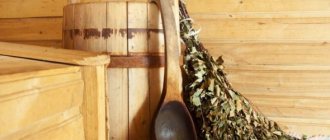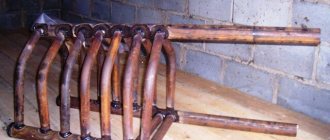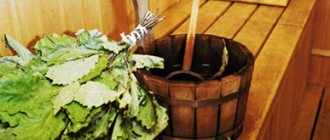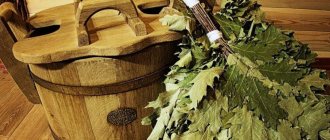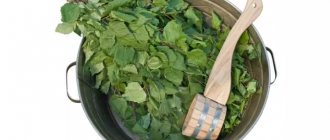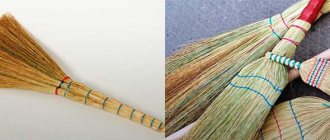Cleanliness is the key to health, and order is above all. This is exactly the phrase that was spoken by the heroes of an old, but still relevant, Soviet cartoon. Various modern means help us keep our house clean - vacuum cleaners, rags made from the latest fabrics, unique chemical compositions... But in everyone’s home there is one more item that helps keep the floor clean - this is an ordinary broom. Now it is somewhat different from its “ancestors” in the manufacturing technique and materials used. What are brooms for sweeping the floor made of?
What are brooms for sweeping the floor made of?
How to make a household broom with your own hands
Tying a simple household broom and growing raw materials for it is not easy; it is important to follow the cultivation technology and dry the stems correctly
How to grow crown sorghum in your garden
Sorghum is not afraid of drought; the growing temperature is much more important for the seeds, since in cold climates the plant does not have time to ripen.
Let us highlight the main points of agricultural technology:
- Seeds can be sown at a temperature not lower than +16 °C.
- It is better to sow 12% more seeds; weak shoots will have to be removed during growth.
- Make row spacing 35-45 cm wide. Seeds need to be sown to a depth of 4 cm, the distance between seeds is up to 2 cm.
- The first weeding is immediately after the seeds germinate, the second is when the sprouts are about 6 cm high, at the same time it is necessary to thin out the seedlings and remove weak shoots. The plant density should be at least 5-10 cm.
- When the seedlings reach a height of 15 cm, a third weeding is carried out, removing poorly developed and weak plants.
- In the autumn, when the panicles have reached waxy ripeness and milk is no longer released when the grain is crushed, you can cut plants at least 1 m long.
- Plants must be hung dry for two weeks in a dark, ventilated area.
- Clean sorghum from grain by placing the stems between the edge of the bucket and the handle. Pull the broom towards you, while pressing the handle with your other hand. The seeds will fall into the bucket. You can also use a comb.
PHOTO: propozitsiya.com Before sowing seeds, you can treat the soil with ammonium nitrate and apply antibacterial protection before throwing out the panicle
PHOTO: texnotoys.ru Cleaning panicles from grain
How to tie a broom at home
After drying, start knitting a broom. There are quite a few manufacturing methods, we have prepared the simplest one that you can use.
Step-by-step instruction
| Illustration | Description of work |
| Distribute the stems into 3 small sheaves, placing the small panicles inside. | |
| Tie one side of a 2 m long rope to the upper support, secure a wooden lever from below. | |
| Take a bunch of sorghum, make a loop around it from a rope, and secure it with a support lever. Rotate the sorghum bunch half a turn and tighten it with a rope as tightly as possible. After this, tie the bundle with synthetic thread. Pull the ends of the thread through the middle of the bundle and hide it inside. | |
| Similarly, fasten the remaining bunches, then cut off several stems and tie them into one bunch. | |
| Tie with twine, pull the ends through the middle of the bundle and hide inside. The excess can be cut off. | |
| Seal the handle 2 more times with a rope at a distance of 10-15 cm from each other and secure with thread. | |
| Trim the ends of the sorghum with a sharp knife. | |
| Use a knife at an angle to clean the cut area. |
You can understand the essence of the work in more detail in this video:
Watch this video on YouTube
Useful properties of sorghum
The plant has many useful qualities:
- promotes the removal of salts from the body;
- excellent antioxidant;
- helps stimulate the production of hemoglobin; the seeds of the plant are often recommended to be included in the diet in the treatment of anemia;
- has a beneficial effect on strengthening the myocardium;
- normalizes blood glucose levels;
- promotes appetite;
- takes part in the production of glucose;
- stimulates brain function;
- helps in accelerating protein synthesis;
- breaks down fats, improves metabolic processes.
We knit a sorghum broom with our own hands
1. Fold the peeled and dried sorghum twigs into a bundle approximately 10-14 cm thick, trim the panicles, compact them and tie them tightly with wire, thick thread or thin rope almost at the very base of the panicles.
2. Choose the tying method yourself, the main thing is that the bun is tight and does not fall apart. Now divide the bundle into three parts and tie each of them separately at a level just below the previous tie.
3. Make three such buns.
4. Then, in the bunches that will be located on the sides of the broom, cut several stems obliquely, stepping back from the trim up the handle by about 5 cm. This is done in order to reduce the thickness of the handle of the future broom.
5. Now gather all three bunches together so that the cut stems on the side bunches are located in the middle of the broom and fit snugly against each other, and tightly tie the broom handle in this place. Make the next straps on the handle every 10 cm.
6. To give the broom a more neat look, trim the broom with scissors so that the rods do not stick out and are the same size. Do the same with the handle.
Types of products
Sorghum brooms come in the following types:
- brooms for floors;
- brooms;
- brooms for cleaning clothes;
- sorghum panicles.
Depending on the method of fastening the working surface, there are:
- brooms with a pierced whisk;
- brooms with a tied whisk.
They are also divided by the number of panicle piercings. The most common:
- double-stitched;
- three-stitched;
- six-pierced.
Where it should always be clean so that money doesn’t go away
In order for wealth to fill the house, you need to make room for it. Do regular cleaning. Remove clutter, clear space.
The kitchen and hallway are special places that should always be clean.
Cuisine is concerned with preparing and eating food. And food has always been considered a sign of prosperity. The richer and more varied the table, the richer the family. This is a place of concentration of monetary energy, which should circulate freely without coming into contact with dirt.
Money can flow with water. Make sure that in the kitchen, the place where wealth is concentrated, the taps are in working order.
The hallway is the border between our home world and the outside world. There shouldn't be any trash here.
Immediately wash the shoes you came in and remove external negativity from them.
To prevent your money from going away, immediately put your shoes on a shelf or in a closet.
Who is entitled to unemployment benefits and how much can you expect?
Remember that you need to clean the apartment during the day, making room for positive, bright flows, including money.
Broom amulet among different nations
Our ancestors believed that the broom served as a resting place for the Domovoy, a good spirit that lives in every home.
A broom for the home was mentioned as a talisman by many ancient peoples. And in some cases, it could even serve as an amulet, attracting certain energies needed by a person. It was with his help that China called for warm, sunny weather during the long rainy season. The Chinese believed that the rains would stop if they hung a homemade broom on the fence near their house.
In European countries, including England, it was believed that a broom could change its positive meaning if used incorrectly. The sign not to sweep or take out trash from the house after sunset appeared precisely on the basis of these beliefs.
However, this amulet was most widespread in Rus'. The Slavs respected the broom, which they used to clean their homes, and also made a special broom-amulet and hung it in certain places.
According to the ideas of our ancestors, the broom served as a resting place for the good spirit that lives in every home - the Brownie. The spirit lived behind the stove, but often rested on a broom, so the housewives monitored the cleanliness of this item and changed it every year, trying to please the protector of the house. After all, if the house is not tidy, the Brownie could get angry and start doing mischief.
What is it and what is it made of?
A household broom is a device through which owners can keep the house clean. Using this product, you can easily remove various dirt and dust accumulations. Despite the fact that today almost every home has a vacuum cleaner, the popularity of brooms has not yet been lost. Various materials are used to make modern brooms for home cleaning.
Let's take a closer look at the most popular of them.
Millet and sorghum. For natural home brooms, millet or sorghum is often used. The most common models are those made from sorghum. This is a cereal plant with dense and strong stems. Several inflorescences extend upward from them. Millet stems can also be used in the production of brooms, but they are less durable.
Rods. Often there are brooms that are made from willow, birch or wolf branches. The main requirement for such blanks is that they be sufficiently thin and soft. At the same time, the materials must be durable. The twigs are cut so that they are of equal length. Next they are tied together. Brooms made from such materials are more rigid, so they are often used outdoors rather than at home.
Lyko. Another material often used in the manufacture of brooms. As a rule, the subbark layer of wood is used as the main raw material. In many cases, preference is given to species such as oak, birch or linden. Lyko is a soft material in its structure. It is subjected to special processing and then divided into fibers.
Polymers. Cleaning products made from polymers are synthetic analogues of natural products. There are many different design options for these devices. Polymer specimens can be painted in different colors and shades. The working side is often made from high-strength plastic wire. One type of synthetic product is a tool made from useless plastic bottles.
Rags. The use of rags in the production of brooms makes it possible to give a second life to unnecessary things. For example, brooms made from old fabric cut into strips are convenient. With this device you can easily deal with dust. In addition, products made from rags can be used for wet cleaning in the house.
Ropes, ropes. To make an effective and convenient device, it is allowed to use strong ropes or ropes. It is possible to use both natural and synthetic material. The principle of making a product of this type is similar to the scheme for creating specimens from rags.
Of course, these are not all the materials from which you can make a good broom for cleaning at home or outside. Many users have options in the production of which plastic, bamboo and other natural or synthetic raw materials were used.
What are brooms for sweeping made of nowadays? Cleaning brushes
Brooms will never go away from everyday use due to the fact that there is a certain number of floor coverings that require careful handling. These are laminate, parquet, some types of tiles (for example, vinyl), etc. In no case should they be cleaned using brute force. And a broom comes in handy here.
Nowadays brooms are also made from polymers. They may have an antistatic brush and a long plastic handle. They are convenient to work with, and such brooms are also good at collecting dirt from the floor covering. Synthetic products can be used to clean any surfaces, they do not scratch anything, do not generate dust (to avoid the dusting effect when cleaning with a regular broom, you have to wet it), they allow you to reach hard-to-reach places and sweep them well.
This is what a modern broom looks like
Synthetic brooms are used for cleaning both residential premises and local areas. They are purchased by enterprises for cleaning production areas. Their main advantage is durability compared to conventional brooms and lack of fragility.
Most often, synthetic brooms are called brushes - they just look exactly like brushes, bearing little resemblance to a standard and familiar broom. They are usually made of PVC. Their cost is greatly influenced by the quality of the raw materials, the length of the handle and bristles of the brush itself, strength and manufacturer brand.
Soft synthetic floor brush
By the way, in modern artificial brooms the length of the sweeping part (broom) has become much shorter than in their predecessor - the traditional broom. But the handle has become longer and can have a variety of configurations. These brooms are lightweight and easy to clean/storage; they can be treated and disinfected with various chemical compounds.
Table. Types of brushes.
| View | Characteristic |
| Rectangular, with long handle | A universal brush, which is used for cleaning floor coverings, cleaning hard-to-reach places, and is often used to remove cobwebs from under the ceiling. Suitable for cleaning carpets, but cleans laminate and parquet well. |
| Laminate brush | Costs more than a universal brush. It has a special pile that carefully and thoroughly cleans laminated flooring or parquet. Also suitable for sweeping away dust from blinds, radiators, etc. |
| Flexible brush | Ideal for cleaning hard-to-reach places and ceilings. It has a long pile and can bend in all directions. The pile itself is also located on a curved strip. |
How to choose?
It must be said that the debate about which broom is better - synthetic or natural - continues to this day. Of course, plastic ones are more practical and durable; they do not wear off on asphalt, unlike natural ones. At the same time, products made from natural materials during use quickly acquire an optimal shape, making it very convenient for her.
Most consumers note that modern domestic brooms are of rather low quality: if in previous years their production was subject to the strict requirements of GOST, today the standards do not apply, so many cheap models become unusable after just a month of use, especially if the cleaning is carried out by housing staff. utilities in intensive mode.
In recent years, many bamboo panicles from China have appeared on the domestic market. Contrary to the opinion that everything that bears the Made in China badge is of low quality, the quality of Chinese cleaning equipment is quite high. Bamboo rods are tied in such a way that they resemble a fan; as a rule, a bamboo cutting is also included in the kit.
Generally speaking, when choosing a broom you should pay attention to some basic parameters:
weight – weight is very important, especially if you have to clean large areas; when purchasing, make sure that the handle is ergonomic - it should be comfortable to hold in your hands, it should not slip or jump out; pay attention to the grip of the rods, try to pull out a few - if they easily leave the bunch - feel free to go buy a broom somewhere else; preference should be given to models with beveled pile - in this case, the garbage will be collected better, and much less effort will be required; if you buy a plastic product, then there should not be any foreign chemical odors coming from it, in addition, the handle should not stain your hands.
How to make a broom from branches, see the video below.
Modern technologies for the production of synthetic materials have turned an ordinary household broom into a modern, convenient tool - a polypropylene broom. This is a cleaning tool with high consumption qualities and a low price.
Such equipment is made from high quality polymers. The pile rods are made using the thread method, and the body with a hole for the handle is pressed from molten polypropylene. The bristles of the bristles are soldered, and therefore they will not fly out even with too much active load.
Brief contents of the article:
Features of a homemade broom
A broom is a small bunch of branches or twigs. The item is often called a broom; it is used to restore order in living quarters or sweep the local area. In addition to its standard purpose, the tool was used by our ancestors to spray laundry or garden crops against pests. When treating plants, it is necessary to dissolve the active substance in water, dip a broom into the liquid and make a sharp movement with your hand.
To make a broom, herbaceous plants and twigs of shrubs no less than 55 cm long are used. They are attached to a small wooden handle with a rope or wire. In addition to natural raw materials, modern brooms are made from synthetic materials (polypropylene threads), which are tied with twine.
Note! From the Old Church Slavonic language, broom is literally translated as “bun”.
Now a broom is considered a standard household tool and is used to clean the floor in any room. With its help, you can clean the floor covering from large debris, which can lead to clogging of the vacuum cleaner. The equipment is recommended to be used for preliminary cleaning of the floor. The broom must be compact and durable, its standard service life is at least 10 months. This is true for products made from cereals or other natural raw materials. After the specified period, the branches dry out and begin to break off, causing more harm than good.
What plants are brooms made from?
First, a little classification. In general, brooms can be divided into two categories: for cleaning indoors and for outdoors. There are home brooms for cleaning the floor and others for dusting. Those for dust are more often called “brooms”. They are made from soft, thin materials that look more like hairs. Once upon a time, a bunch of feathers were used for these purposes; now, more and more often, synthetic fibers are secured with a fan or a “brush”. All this beauty is attached to the handle.
What is a broom made from... But traditionally it is made from millet and sorghum
Household or home floor brooms are designed to remove not only small debris, but also to capture dust. They are softer and denser than those for the street. Collected from a large number of thin elastic branches/lint. They are given a “broom” shape: the handle is round, the lower part is flat. Due to the width, a considerable area is captured in one pass. So this shape is not accidental.
A broom differs from a broom in the presence of a handle
A broom for cleaning outside is tougher. This weapon is often called a broom, but a “street broom” is also in use. It is made of thin branches and twigs. They are tougher and more elastic. After all, they don’t have to chase dust and crumbs around the house. You need to remove stones, leaves, branches or something similar. So you need not only thickness, but also elasticity to make it convenient to remove debris. But they cannot grab sand, soil and other “trifles”, so there are often two “tools of labor” on the street - a broom and a broom.
Brooms are made from broom sorghum
There is even a special variety that was bred specifically for making brooms. That’s why it’s called sorghum broom. It is grown specifically for making brooms. The plant is unpretentious and does not require special care. In some areas it is called “broom”.
Sorghum is cut, leaves removed, dried, turning the panicle down. The seeds are removed from the dried stems. There is an old way of cleaning seeds - using a galvanized bucket. The whisk is clamped between the rim and the handle of the bucket and pulled towards you. Some of the seeds fall into the bucket, some still remain. This process is repeated until everything is clean. Parrots love sorghum seeds, and chickens do not pass by. So the benefits of growing this plant are double.
Preparing sorghum or millet
In order for a sorghum or millet broom to serve for a long time, it must be prepared before use - steamed. You will need a bucket of hot water (boiling water or almost boiling water). You need to dissolve a glass of regular table salt in water. Dip a broom into the solution and leave for at least two hours. This simple procedure makes it more resilient and branches break less often. In general, a steamed broom lasts longer.
To make a broom soft and durable, you need to steam it in boiling water for two hours.
An outdoor broom is often called a broom. It is usually made from thin branches and twigs. There are practically no secrets here. Young one-year-old shoots are cut about a meter long. These are the plants that are good for a broom:
- Willow shoots.
- Birch.
- Boxthorn.
These are common ones. But they are also made from other bushes or tree branches. Even annuals are used: wormwood, kaoliang (a plant very similar to millet or sorghum), kochia.
A certain number of branches are collected in a bundle, aligning them along the cut. The upper part is pulled together in two to four places. This tie forms the handle. But, firstly, the handle is too thick, and secondly, to clean it on the street, you will have to stand for a long time “in an inclined position.” Therefore, the broom is attached to a wooden or plastic handle.
They also make a broom out of plastic bottles. The process is quite simple and everyone has bottles. They are cut into strips, inserted one into the other, and secured. Making it is no more difficult, and probably even easier, than using traditional materials. So, here's the procedure:
- Cut off the bottom of the first bottle.
- Cut the “body” of the bottle into thin strips. Do not cut 4-6 cm to the neck.
- For everyone else, we cut off both the neck and the bottom. We cut off the neck 2-3 cm below the place where the thickening begins.
- We cut it into thin strips and put it on the first piece - the one with the neck.
- In total, you can insert 5-8 pieces one into the other.
- We cut off the neck of another bottle like the others. Cut off 2/3 from the bottom. We put the remaining 1/3 with the neck cut off onto the broom blank. This will be a “case” that gives the plastic broom its usual shape for a broom.
- Somewhere in the area where the thread for the lid is cut, we pierce a hole with an awl. This is for attaching to a broom handle.
- The edge of the holder must be sharpened so that it fits into the neck of the bottle at least 5 cm.
- We insert the holder and screw the screw through the hole.
- Now we squeeze it at the bottom of the “case”, forming the flat part of the broom.
- We take a coarse thread or wire, scissors or an awl. We pierce the “cover” in at least two places, but more often. We thread the wire through the holes, tighten it, and twist it.
Recommendations
When choosing a broom for cleaning, it is advisable to consider the following points:
- A broom differs from a broom in shape and material of manufacture. For brooms made from natural raw materials, sorghum or millet is used, and for brooms, mainly willow or birch twigs are used. The handle in this case is most often a plastic or wooden shaft.
- Without brewing, a natural broom will last less.
- Brooms that are made from sorghum industrially must comply with the technical specifications of OST
- In order to extend the life of any of the brooms, it is important to store them correctly. It is best to place the cleaning product horizontally rather than vertically.
An alternative to traditional hand brooms is an electric broom, which has various attachments.
Methods for steaming bath brooms
Preparing birch harvest includes several steps. By following them, you will achieve the best result. Rinse the accessory in warm water and keep in cold water for two minutes.
Afterwards, pay attention to the leaves by dipping them in a liquid heated to 40 degrees for several minutes. The next step is to add boiling water and leave it covered for fifteen minutes.
The product will acquire a luxurious aroma if it is dried a little over hot stones. Try not to overdo it, this will prevent the foliage from sticking together. Oak, processed using the previous method. The revelation of its medicinal properties will depend on how to steam a bath broom correctly and in what water. The moment of the parka reveals the features completely. It is quite easy to prepare the desired product from oak branches. As a result, you will feel a calming effect on the body, and especially on the nervous system. Strengthening blood vessels, stabilizing blood pressure and improving cardiac function. Oak leaves are famous for their tanning properties, giving elasticity and matteness to the skin. They regulate the functions of the sebaceous glands. Linden gives excellent results. Thanks to enzymes, it is a preventive measure for vegetative-vascular dystonia and helps well in treatment. This disease provokes exacerbation of migraines and insomnia. Linden steam quickly relieves unpleasant symptoms. The tree was once called royal because of the lightness of the wood and delicate leaves. Since ancient times, this plant has symbolized balance and tranquility. Flower collection is a folk medicine that relieves headaches. The beneficial aroma works as an antiseptic and is good for colds. A pine accessory, despite its luxurious aroma, will not bring satisfaction to everyone. This product is kept in boiling water for about half an hour, with the lid tightly closed. This is necessary so that the essential oils do not evaporate and the needles soften. Even after careful preparation, people with sensitive skin will not experience the pleasure of being whipped with hard rods. It is better to choose a more gentle option.
When preparing the procedure, do not pour out the liquid after soaking. It retains many useful substances that will give life to your hair better than store-bought cosmetics. This water can remove dandruff, strengthen hair follicles and give a healthy shine.
We suggest you familiarize yourself with How much clay is needed for laying a stove
Now, when you are going to take a steam bath with your family or friends, you know why you need to steam a bath broom, how to do it quickly, and bring the greatest benefit to the body.
Please note that this article is for informational purposes only and under no circumstances is it a public offer as defined by the provisions of Article 437 (2) of the Civil Code of the Russian Federation
- You cannot use a broom to break branches from a burnt tree. Make sure that the tree for the broom is healthy and strong, without growths and other diseases.
- It is also a bad omen to break branches from a tree for a bath, which is divided into 2 large trunks from the very root.
- Do not torture the tree by cutting off a whole broom from one branch. So you will lose the favor of the bannik - the spirit of the bathhouse.
- Ask the tree for forgiveness when you break its branches and cause pain to it. And then the broom will be softer.
- Tie a broom during the full moon - that’s when the trees have more power, and the shoots have magical properties.
- Brooms, which were prepared on July 6, are healing. It is on this day that the collected herbs and plants have special healing powers.
- You cannot take someone else’s bath broom - this way you can take away his illnesses for yourself. By the way, it’s not just about signs. After all, if a person has skin diseases, then with a steamed broom you can easily transfer them to yourself.
- The ancestors considered it absolutely unacceptable to use a broom that had previously been used by a woman. Since often in ancient times women were equated with witches.
Banya broom
- After visiting the bathhouse, leave the bathhouse with soap and water and a broom. Otherwise, he will be offended and next time he may scald you with boiling water or split a stone.
- Tie the brooms well, as a broken broom means an imminent outbreak of disease.
- If it’s time to throw away the broom, then unlike a regular broom, a bath broom can be easily thrown away and burned.
- To remove the damage from yourself, after reading the “Our Father” you need to give yourself a good beating with a broom. Leave the broom to dry and burn it after a week.
- For a successful life, a young family needs to be steamed with a broom of 7 branches, which should be plucked from different willows growing near the water.
- After the bath, take 2 twigs from the broom and, after reading “Our Father,” put them under the pillow. The sleep will be very sound.
Steaming: why is it necessary?
After purchasing a new natural broom, it should be treated - steamed. Such preparation for the operation of the tool is necessary in order for the broom to serve for a long time and have good performance indicators.
How to steam or soak a broom? For steaming you need to prepare:
- bucket;
- boiling water;
- 1 tbsp. kitchen salt.
Procedure:
- Pour boiling water into the bucket.
- Pour salt into the water.
- Stir.
- Place a broom whisk in the bucket.
- Leave to infuse for at least two hours.
After soaking in boiling water, the branches will become elastic and soft. As a result, they will not break quickly, and the tool itself will last much longer.
Getting rid of an old broom and buying a new one
According to popular belief, a cleaning item that has served its purpose should be thrown away. Otherwise, those who wish harm to their household can use it to perform a magical ritual (for example, damage, curse).
Getting rid of an attribute that is no longer needed:
- You need to take it away from your home and land. If you put an object in the nearest container, you can attract sleep disorders and various diseases.
- Destroying a broom with fire is prohibited. Such a measure will lead to bad weather, scandals in the family, and an invasion of insects (midges, cockroaches, bugs).
Before you go shopping for new cleaning equipment, there are a few tips to consider. They will allow you to protect yourself and your loved ones from health and financial problems.
Features of purchasing a new household “helper”:
- It is advisable to go to the store on men's days. And there are only three of them - Monday, Tuesday and Thursday.
- It is advisable to buy this item from a male seller. However, you cannot bargain.
- August is not a good month to replace an old broom with a new one. Indeed, in this case, the owner of the house and his family members will face additional troubles.
- The ideal period for buying is the days when the Moon is waxing and not waning.
- When the seller hands the product into your hands, you need to mentally make a wish. There is a high probability that it will come true.
- The purchased equipment must be immediately tested in practice. For example, sweep the garbage out of the room onto the street (if it is a private house). This way you will attract financial success.
- Those wishing to improve their financial situation should make a purchase on New Year's days.
Caring for a broom during use
The rules are simple and clear, and their implementation guarantees the use of the broom for a longer time:
- A new broom must be steamed in a weak salt solution. To do this, pour 2 tablespoons of table salt into 8 liters of boiling water, mix well and immerse a broom in it. The instrument is kept in the solution until it cools completely, and once every 30-40 minutes it is necessary to invigorate the panicle in the water with smooth but energetic movements. This is followed by good shaking to remove excess water and drying under a small, 1-2 kilogram load, in a horizontal position at room temperature.
- To avoid breakage and deformation bending of the sweeping part, the broom is stored horizontally. If this orientation of the tool is not possible, it is held on the handle, vertically, with the working part up. By the way, according to knowledgeable people, a broom in this position protects the house and its household from the evil eye and dashing people. The same people assure that it is in the broom that the brownie or bannik finds temporary shelter, therefore one must treat this cleaning instrument with restraint and respect.
What to do with the branches after harvesting?
An attic space is a good place to store harvested branches, or a heap of hay is even better. A balcony or even a mezzanine is suitable for storing workpieces in urban conditions. In this case, the brooms will need to be pre-wrapped in paper bags.
Drying brooms
Drying brooms on the roof of the barn is also allowed. This is done in the following sequence:
- meadow hay is spread over the roof;
- birch branches are laid out on the hay with small gaps;
- a layer of hay is laid out on top of the branches;
- Every day (some experts advise increasing this period to 2-3 days) the branches turn over. This is done over the course of a month.
Most often, dried pieces are tied in pairs to a rope and stored in this position. You don’t have to knit brooms right away, but combine the branches into small sheaves. The sheaves are wrapped in hay and stored in the attic. Before going to the bathhouse, the required number of branches is pulled from the sheaf and tied into a broom.
What are the best bath brooms?
Wedding decorations: what are they and how to make them yourself?
Not every broom is good, and craftsmen who can skillfully assemble and weave it have long been especially valued
Special attention was paid to the composition and size, because each plant used in the set has its own distinctive properties, aroma and benefits. Today you can buy a broom for a bathhouse, and for this you do not need to look for a specialist, go to the forest or even leave the house
However, you need to know what kind of broom you need, what beneficial qualities are preferable for you.
You will be surprised, but brooms, in addition to birch and oak, are knitted from all kinds of plants: eucalyptus, nettle, bird cherry, currant, wormwood, alder, rowan, hazel and so on. Each collection has its own advantages and is often used in combination, providing comprehensive care and benefits. Some plants simply give a pleasant aroma, for example, like cherry, or have medicinal properties, for example, linden will help get rid of colds and headaches.
It will be useful to know. The most popular types, which are most often taken with bathing experts.
Oak broom.
Considered masculine, the most durable of all options. One properly prepared bundle is enough for several steam rooms. It is able to relieve severe muscle tension and has a real massage effect, helping to normalize blood pressure and skin.
Birch broom.
It is rightfully considered the king of the bathhouse and is used most often. It is famous for its subtle, pleasant aroma that lingers on the body after a steam room for at least five hours. Knitted from curly birch will serve as an irreplaceable and durable assistant. It has an anti-inflammatory and wound-healing effect, is useful for rheumatism, relieves joint pain, deeply cleanses the skin and is indispensable for people with breathing problems.
Linden broom.
The softness of linden leaves gives such a bunch, when used, the opportunity to carry out a more gentle massage than, for example, oak or birch. The medicinal properties of this plant have been known for a long time and are used for chronic bronchitis and colds. Moreover, a bathhouse with such an assistant will easily relieve headaches and delight you with a pleasant aroma.
Juniper broom.
Used exclusively by experienced users, you should not go to the bathhouse for the first time with such a combination
To give it softness and protect yourself from unpleasant sensations, you will have to keep the bunch in hot water for at least 10 minutes and use it carefully and wisely. Despite the complexity and nuances of use, the juniper ligament will bring incredible benefits to people suffering from rheumatism and radiculitis.
Moreover, it is famous for its antibacterial properties, which no ligament can compare with.
When planning to take a steam bath, choose a broom carefully. When steamed, fresh will certainly become heavy and will heat up faster, burning the skin much more strongly than dry. This is why you should opt for prepared bundles
Pay attention to the size of the leaves, the larger the better, they should not fall off and must be green. Many experienced steamers advise taking with you a thin enough knitting, for a better massage effect and the absence of injuries and calluses, with the stems tightly tied with fabric
Give preference to brooms with a pleasant and strong aroma and a trip to the bathhouse will leave a pleasant impression and give you health and beauty.
LiveInternetLiveInternet
—Categories
- KNITTING: CROCHET, SPOKES. SEWING, CRAFTS (Hobby) (1681)
- DECOR, DECOUPAGE (64)
- MAGAZINES-3 (50)
- MAGAZINES-2 (50)
- MAGAZINES (50)
- Sewing-2 (50)
- Sewing (50)
- Jackets, sweaters - No. 2 (50)
- Jackets, sweaters (50)
- Beading (22)
- MAGAZINES-4 (15)
- Jackets, sweaters No. 3 (12)
- embroidery (6)
- Sewing-3 (5)
- Internet, LiRu, programs, earnings, STUDY, BUSINESS (838)
- COOKING. Recipes for tea, drinks. Dessert. BAKERY (831)
- HEALTH: gymnastics, meditation, dancing, healthy and (634)
- EXERCISES FOR FACE AND NECK (47)
- inserts in comments, frames, diagrams, WALLPAPERS, BACKGROUND (507)
- HOLIDAY, GIFTS, EVENTS (502)
- Events of the Day - January (37)
- Events of the Day - December (37)
- Events of the Day - May (37)
- Events of the day - October (34)
- Events of the Day - April (34)
- Events of the Day - March (33)
- Events of the Day - September (33)
- Events of the Day - November (32)
- Events of the Day - February (31)
- Events of the Day - July (31)
- Events of the Day - June (30)
- Events of the Day - August (25)
- COOKING. Main course recipes (495)
- music, various songs (460)
- Valery Leontyev (422)
- TESTS, RIDDLES (421)
- Astronomy. Astrology (horoscopes). Psychic (304)
- video creation, flash, animation, photoshop (296)
- ECOLOGY, animals, birds, fish, flowers, nature (276)
- DESIGN, HOUSE, construction, MOVING, Utilities (257)
- Fashion, beauty, CHARM (250)
- WATCH MOVIES, cartoons (233)
- RELATIONSHIPS, FAMILY, PSYCHOLOGY, QUOTES (222)
- frames (216)
- EQUIPMENT, technology, SCIENCE, production (202)
- MILITARY THEME (5)
- TRAVEL, RECREATION, LANGUAGES and COUNTRIES, CITIES, VILLAGES (191)
- FUNNY AND VERY FUNNY (178)
- Miscellaneous (173)
- About the stars, interviews (150)
- Pictures, photos, photos of paintings, ART miscellaneous (148)
- POLICY. Politicians. ECONOMY (134)
- CREATION. PAINTING.Miscellaneous (124)
- INTERESTING FACTS (123)
- All about GAMES (117)
- SCHEMES (117)
- Vladimir Vysotsky (111)
- About great, famous, famous people (108)
- GARDEN WORK. PLANTS (106)
- Construction at the dacha (13)
- poems (104)
- Prayers, sacred things, PARABLES, SIGNS (102)
- LiRu's friends, photos, interviews, miscellaneous (101)
- Experienced. Memorable (92)
- Canning, PREPARATIONS (89)
- Kurgan and Kurgan people, From the KIK newspaper (77)
- My videos, song clips (74)
- CLIPART, SEPARATORS, ANIMATION (73)
- Scorpions and others (73)
- COOKING. Soups, liquid dishes (69)
- My photos, personal (69)
- I'm looking for you, mom. SEARCH (64)
- radio recordings, radio plays, online books (60)
- Chess, SPORTS (51)
- PHOTOGRAPHY (50)
- FORGOTTEN SONGS, OLD SONGS, OLD HITTS (44)
- SITE CREATION. For bloggers. CODES (41)
- Website from scratch (7)
- Legal assistance, Miscellaneous SERVICES (38)
- MUDRA (Health), MANTRAS, Relax (29)
- Books, BOOKS ONLINE. Quotes (27)
- World War II, WWII 1941-1945 (26)
- WEBINARS, CONFERENCES, TRAININGS (24)
- Alla Pugacheva (20)
- Thomas Anders (19)
- brother's poems (19)
- HOW TO OVERCOME A DISEASE. DISEASE PREVENTION (16)
- HISTORY OF RUSSIA, USSR, rulers (16)
- TV, radio channels (16)
- PANORAMAS (14)
- ENTERTAINMENT (13)
- dancing, ballet (13)
- Semyon Slepakov (12)
- lyrical songs (12)
- Sergey Bezrukov. Films, theater, etc. (11)
- Chess, SPORT-2 (10)
- CHRIS NORMAN SMOKIE (Chris Norman, “Smokey” (9)
- FRANCE. Parisian secrets (9)
- EFFECTS (7)
- GRAVITY (7)
- My frames (6)
- DICTIONARIES, REFERENCE BOOKS, rules (6)
- Ozzy Osbourne (5)
- Lyubov Uspenskaya (4)
- Alexander Rosenbaum (4)
- SPORT 2 (2)
- Burned! (2)
- Photo 2 (1)
- What's happening to us? (1)
- CERTIFICATES (1)
- If you suddenly need it))) (1)
- (0)
—Quote book
Players - Valentines 3 (click on the white circle on the heart)
Three simple frames for writing YOUR TEXT YOUR TEXT YOUR TEXT YOUR TEXT YOUR TEXT.
Happy New Year! With a new player! .
VALERY LEONTIEV “Have pity on me” (Song of the year 2019) geniavegas
The artist paints paintings that glow from within. The artist paints pictures that St.
—Applications
- Cheap flights
Favorable prices, easy search, no commission, 24 hours. Book now - pay later! - always no analogues at hand
^_^ Allows you to insert a panel with an arbitrary Html code into your profile. You can place banners, counters, etc. there - Postcards
Reborn catalog of postcards for all occasions - I am a photographer
Plugin for publishing photos in the user's diary. Minimum system requirements: Internet Explorer 6, Fire Fox 1.5, Opera 9.5, Safari 3.1.1 with JavaScript enabled. Maybe it will work - 5 friends
List of friends with description. This application allows you to place a block on your blog or profile containing entries about 5 of your friends. The content of the signature can be anything - from a declaration of love to
Both helper and protector
The life of a peasant family in Rus' was unpretentious and simple: they plowed with a plow, carried water with a bucket, and rode in the snow on a sleigh. But sweep away the dirty linen from the hut or in the yard with tied rods, called a broom. According to one version, “broom” is an Old Slavonic word and means “bundle.” Of course; there was one broom or broom for the yard, and another for the hut. For the hut, a broom was knitted from flexible birch twigs with leaves. Sometimes aspen or alder branches were used. Moreover, it was necessary to break them into brooms only in the spring, when they were juicy and flexible. But they preferred to make yard brooms from the shoots of a plant such as chiliga, or wild acacia, which was distinguished by strong and flexible branches. They were too rough for a hut, but on the ground they were just right. Brooms were also knitted from common wolfberry, a shrub better known as wolfberry. It was especially chic to sweep the hut with a fragrant broom made from St. John's wort, wormwood or oregano. After such cleaning, a pleasant smell appeared in the room, but the broom itself in this case was disposable. In Rus', it was believed that if you sweep a hut with a reed broom, then spiders will emerge from it, weaving webs in the corners. In many provinces there was a belief that a brownie could live in a broom, and along with a broom, it was associated with a place of attraction for evil spirits. When things began to disappear, and household members were arguing, they beat the entrance threshold with a broom to drive away someone else's brownie. There was a belief that a witch, in order to deprive a cow of milk from a person she did not like, first knocked off the dew from the grass with a broom, and then touched the animal’s udder with this broom. And if the witch dragged a broom over the crops, then their owner was deprived of the harvest. Moreover, in other cases, the broom was both a talisman and a talisman. Thus, it was prescribed to place a broom in the house with the handle down in order to attract wealth into the house. They tried to throw a broom after an evil person who could cast the evil eye or cause damage, so that he could not bring trouble to the owners of the house. After the funeral, it was prescribed to sweep the floor from the place where the coffin with the deceased stood to the threshold, and then immediately burn the broom. They acted in a similar way with a broom that had served its purpose - golik. It was not thrown away, but burned on Maslenitsa. In Russian villages it was considered unacceptable to wave a broom above table level. And stepping over a pregnant woman’s broom meant inviting a difficult birth. In the new hut, it was strictly prescribed to take revenge only with a new broom, since the old one could store the negative energy of the old place. The broom rods gathered together were considered an example of strength in unity. There is a saying in Russian: “You can’t break a broom, but you can break the whole twig.” It is possible that it was she who pushed the writer Leo Tolstoy to write a parable about how a father told his sons to try to break a broom, but nothing came of it. And then he allowed them to break it one twig at a time, and they did it easily.
Preparing seeds for planting
As soon as the soil warms up to a temperature of 12-15 degrees Celsius, you can begin preparing the seeds. 24 hours before sowing, the seeds are soaked in warm water, then they are ventilated and sown immediately. The timing of sorghum seed sowing in open ground often coincides with the period of planting seedlings of other plants. The main thing in the process of planting sorghum seeds is the correct depth of seed placement. The best option is hard, moist soil with a planting depth of 5-6 cm. The distance between rows should be wide (row spacing 60-70 cm).
Under good weather conditions, after 6-8 days the sorghum plant produces its first shoots. During the first 30 days, the above-ground part develops at a slow pace, since at this time a powerful root system is being formed
During this period, it is important to carry out weeding and thinning of crops in a timely manner, since dense sowing will not allow the plant to form a panicle. During the entire growing season, the plant is loosened at least 3 times.
The plant practically does not require watering, except for the time when the panicle is formed. At this time, he uses the technique of flooding crops.
Harvesting a sorghum plant
This happens when its seeds are fully ripe (depending on the planting period) - from the end of August to mid-September.
The maturity of the plant can be determined by the yellowed stem, which has reached two meters in height, and the red-brown color of the brush. If everything is so, then it’s time to collect sorghum twigs for the future broom.
Next, a rather labor-intensive process awaits you, so you should be patient. The plant is mowed down to the very root using a scythe or sickle, and then trimmed with a knife so that the stem is about a meter long.
The mowed plant must be dried well. To do this, the stems are carefully folded one next to the other and hung in the sun with the panicles facing up. After complete drying, the stems are thoroughly cleaned of leaves and seeds.
What plants are brooms made from?
An outdoor broom is often called a broom. It is usually made from thin branches and twigs. There are practically no secrets here. Young one-year-old shoots are cut about a meter long. These are the plants that are good for a broom:
These are common ones. But they are also made from other bushes or tree branches. Even annuals are used: wormwood, kaoliang (a plant very similar to millet or sorghum), kochia.
A certain number of branches are collected in a bundle, aligning them along the cut. The upper part is pulled together in two to four places. This tie forms the handle. But, firstly, the handle is too thick, and secondly, to clean it on the street, you will have to stand for a long time “in an inclined position.” Therefore, the broom is attached to a wooden or plastic handle. The diameter of the handle is not too large to be comfortable to grasp with your hand. The load is small, so 3-4 cm is enough. The holder is often switched from an old broom to a new one.
Master class on creating a broom amulet from bast and jute threads
In order to make a talisman using bast and jute threads, we suggest that you familiarize yourself with a special master class.
To make a protective broom you will need some tools and materials:
- bast;
- jute thread;
- scissors;
- glue;
- decorative symbols.
The process of making a talisman is quite simple and even a schoolchild can do it:
Manual for making a talisman broom from bast and jute threads with your own hands.
- We collect the bast into a bundle and tie it on top with a jute rope, fastening it into a ring with a small knot.
- We skip a short distance from the first harness and wrap the bundle with rope again, creating a second ring. Thus we get a handle for the future amulet.
- Next, you need to straighten the broom so that you get a kind of fan. Separate a small bundle and wrap it with rope. In the same way, we wind the rope around the next bundle, tying it to the first. We divide the rest of the bast into bunches and treat them similarly to the first two. As a result, we get a broom - the basis for the amulet.
- Using glue, we decorate the base with decorative elements that have symbolic meaning.
